聚丙烯酰胺/蒙脱土渗灌材料制备及其导水性能野外试验
渠永平,张增志
聚丙烯酰胺/蒙脱土渗灌材料制备及其导水性能野外试验
渠永平1,2,张增志3
(1. 中北大学材料科学与工程学院,太原 030051;2. 中北大学矿物功能材料研究所,太原 030051;3. 中国矿业大学(北京)生态功能材料研究所,北京 100083))
基于沙生植物微需水量的特点,利用聚丙烯酰胺(Polyacrylamide,PAM)和蒙脱土(Montmorillonite,MMT)复合制备了一种渗灌复合材料,研究了材料的成膜性能和吸释水性能,并对渗灌系统的自调节导水性能进行了研究,然后在乌兰布和沙漠进行了渗灌系统的野外试验,最后利用X射线衍射仪、红外光谱分析仪和扫描电子显微镜对复合材料自调节导水机理进行分析。结果表明:PAM与MMT的最佳质量比为0.25,PAM和MMT制备的复合导水材料可在纤维表面形成均匀连续的膜,且导水材料的吸水和释水性能较为均衡,干湿交替试验显示其可根据土壤湿度自调节导水速率。沙漠野外试验表明,肉苁蓉接种率从对照组的23%提高到86%。材料微观分析表明:PAM通过插层作用进入MMT片层间形成复合导水材料,导水材料主要依靠PAM和MMT的相互作用传导水分,PAM的干燥收缩和吸水溶胀会引起MMT的连接和分开,从而引起水分传导速率的变化。研究结果可为渗灌材料的应用提供参考。
荒漠化;聚丙烯酰胺;蒙脱土;渗灌;导水
0 引 言
荒漠化是威胁人类生存的八大灾难之一[1],荒漠化治理一直是研究热点。众多荒漠化治理技术中,生物固沙是一种最根本、最彻底的技术[2]。在降雨稀少的荒漠地区,为植物提供其生长必需的水分离不开节水灌溉[3]。现有的节水灌溉技术中,节水效率较高的是滴灌和渗灌[4]。滴灌技术目前主要应用于需水量较大的棉花、玉米、西红柿等作物[5-9],在微需水量的固沙苗木上应用较少。渗灌技术通过渗水的方式(即让水分从渗灌管壁上的微孔由内而外呈发汗式一点点渗出),待其还未形成水滴前被土壤吸收,之后通过毛细管作用力在土壤中传递,直到植物根部土壤,因此其水分利用效率更高[10]。
目前渗灌技术大多依靠压力和机械孔道的协同作用调控供水速率,是一种被动式的调控方式,其出水速率不能根据植物需水规律进行自动调节,而且其出水速率一般都大于1 L/h,远大于沙生耐旱植物的用水需求。渗灌技术多采用陶土管和橡胶管。学者们已研究了多种新型材料制备的渗灌管和渗灌头[11-13]。仵峰等[14]利用作物秸秆与土壤混合制备了具有渗水能力的复合渗灌管,其渗水速率约为0.76~1.40 L/(m·h)。梁海军等[15]研究了橡塑渗灌管及其水分运移模型。李向明等[16]以砂子、水泥、硅溶胶为原料,采用干压结合雾化加湿法制备了混凝土灌水器,研究了灌水器的形状及参数对流量的影响。蔡耀辉等[12,17-18]先后制备了黏土基微孔陶瓷、硅藻土微孔陶瓷灌水器,并将其水分运移特性与地下滴灌进行了对比研究,发现相同灌溉时间下微孔陶瓷渗灌的累计入渗量、湿润锋运移距离、湿润体截面面积均明显小于地下滴灌。也有学者[19]研究了渗灌技术应用下土壤中元素的分布规律。
近年来,本研究团队针对沙生植物的微需水量的特点,设计了一种由聚丙烯酰胺(Polyacrylamide,PAM)和蒙脱土(Montmorillonite,MMT)复合而成的导水材料。这种复合材料充分利用了PAM很强的保水性能和MMT较好的导水性能[20],导水性能和保水性能较为均衡。复合导水材料中,MMT可作为水分快速传递的通道,而PAM可对水分的传递进行调节[21]。本研究团队针对这种复合导水材料进行了初步的研究,但主要集中在材料制备工艺和实验室内的吸水、保水性能探讨[22-25]。复合导水材料作为渗灌控水头的核心,其与渗灌头的匹配性、渗灌系统整体结构的设计、渗灌系统在干湿交替环境下的稳定性、渗灌系统在沙漠现场应用中对苗木成活率的影响以及与传统灌溉技术相比的节水效果的定量化研究等均尚未开展,相关基础数据的缺乏,制约了该渗灌技术的进一步推广应用。因此,本研究制备了这种复合材料,重点对由这种复合材料制备的渗灌系统在干湿交替环境下的稳定性和荒漠化地区的现场应用进行了研究,在此基础上,对材料微观结构在导水过程中的动态变化进行了观察,从材料学的角度对渗灌材料自动调节导水的机理进行了研究,以期为PAM/MMT渗灌复合材料的推广以及荒漠地区开展渗灌提供参考。
1 材料与方法
1.1 主要原料
蒙脱土(MMT),最大粒径小于74m,浙江丰虹新材料股份有限公司;聚丙烯酰胺(PAM),分析纯,法国爱森公司;棉纤维,化学纯,成都普思生物科技股份有限公司。
1.2 渗灌复合材料制备及渗灌系统设计
图1所示为PAM/MMT渗灌材料制备过程示意图,PAM/MMT复合材料。为寻求最佳配比,根据前人研究,将PAM和MMT的质量比设定为0.05、0.10、0.15、0.20、0.25和0.30,将各组试样分别命名为M1、M2、M3、M4、M5和M6。制备过程参考文献[25]。

图1 聚丙烯酰胺和蒙脱土渗灌复合材料制备过程
根据成膜性能和吸释水性能,选择最佳配比制备滴头,将导水纤维填充到自制的渗灌头中,利用渗灌头与管路组成渗灌系统,渗灌系统设计图见图2。

图2 渗灌系统设计
1.3 渗灌复合材料室内试验与性能分析
1.3.1 成膜性能
用日本日立S-3400型电子显微镜观察各组导水材料在纤维表面涂覆的微观形貌,分析其在纤维表面的成膜性能。
1.3.2 吸释性能
1)吸水试验:将蒙脱土和聚丙烯酰胺的混合液烘干后制成2 cm×2 cm×0.5 cm的块状固体,在60 ℃下烘干后用纱布将其包裹放入水中,定时取出称质量M并记录,直到充分吸水后质量不再明显变化。
2)释水试验:将充分吸水后的各试样分为2组,一组在室温下空气中测定其在设定时间内的质量M并记录;另一组将各试样(纱布包裹)放入干燥的沙土中,定时测定其质量M并记录。将试样测试前的质量记为0,试样吸水饱和后质量记为1,则吸水率(Q,g/g)、空气中释水率(Q,g/g)和沙土中释水率(Q,g/g)计算公式如下

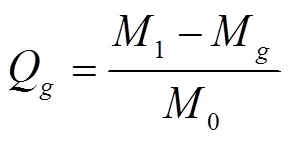
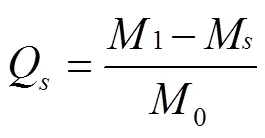
1.4 渗灌系统导水性能分析
开展室内导水试验和沙漠现场试验研究渗灌系统导水性能。
室内导水试验:将渗灌滴头埋入自制沙箱中,埋深10 cm,水源处不加外压,试验开始后定时测量其出水量大小变化,试验设计5个平行样。24 h导水性能测试中每1 h测定1次出水量,7 d导水性能测试中每1 d测定1次出水量。干湿循环导水性能测试中将渗灌滴头用纱布包裹后埋入干沙中,干沙为用烘箱将沙子烘干到质量不再变化为止,每1 d测定1次出水量,渗灌4 d后将其整体移入另一个自制沙箱的干沙中继续试验,共计干湿循环3次。
沙漠现场试验:沙漠现场试验选在内蒙古磴口县的乌兰布和沙漠,根据气象资料统计,试验区年降水量最大和最小值分别为150.3和33.3 mm,年均降水量和年均蒸发量分别为102.9和2 258.8 mm,最高气温、最低气温和平均气温分别为39、-29.6和7.8 ℃。试验对象选择对水分条件较敏感的肉苁蓉,肉苁蓉是寄生在固沙植物梭梭根部的寄生植物,肉苁蓉接种期和生长期适宜的土壤含水率为3%~18%[26-28],水分过大或过小都不易成活。试验时间共计6个月(2018年3月15日—9月15日),试验设置为2个试验组:A组为对照组,采用当地传统的蓄水坑灌方式(图3)。在梭梭苗接种肉苁蓉的一侧挖三角形的蓄水坑,深度约为70 cm。灌溉过程中根据天气情况不定期浇水(浇水不宜过多,以地下0.7 m深处沙子略有湿气为佳),每次灌水时将蓄水坑中灌满水分,每次灌水时记录用水量1i,接种期6个月共浇水4次,试验期结束计算总用水量(1总,L)。B组为渗灌组,采用集中供水方式,利用水箱(50 L)储存水分,通过渗灌管路系统将水分直接送达植物根部附近。

图3 蓄水坑灌示意图
试验开始时水箱中加满水,每次当水箱中液面下降到箱体1/3时补充水分至水箱加满并记录加水量2i。接种期6个月共加水3次,接种期结束后桶内剩余水量为2余,试验期结束计算总用水量(2总,L)。试验设计为每组各接种100棵,共计200棵,接种期结束查看接种情况并统计成功接种株数,并计算接种率(,%)。1总、2总和的计算公式如下



式中11、12、13、14分别代表蓄水坑灌方式中第1、2、3、4次灌溉用水量,mm;21、22、23分别代表渗灌方式中第1、2、3次灌溉用水量,mm;2余代表接种期结束后桶内剩余水量,mm。
图4为荒漠化现场试验图,渗灌系统供水水源处不加压,略高于地面,保证水分可在管路中自由流动,管路系统包括干路和支路,通过支路毛管的设置将渗灌头直接置于植物根部附近土壤,减少水分无效下渗损失。

图4 沙漠现场试验照片
导水机理分析:用美国尼高力公司NEXUS 670FT-IR光谱仪对PAM和MMT制备的复合导水材料进行红外光谱分析,测试范围4 000~500 cm-1,扫描次数128次,分辨率8 cm-1。用日本理学D/MAX—2200PC型X射线衍射仪测定PAM和MMT制备的复合导水材料的XRD图谱,铜靶(=0.15 nm),管电流100 mA,扫描速度5°/min。
采用Quanta2000型环境扫描电镜,对PAM和MMT制备的复合导水材料的微观形貌进行分析。试验中将环境扫描电镜与冷台操作配合使用,通过对可变真空度的调节,实现对复合材料不同含水率状态的调节,以此模拟导水过程中的不同导水阶段,从而观察分析材料微观结构随含水率的变化情况。
2 结果与分析
2.1 渗灌复合材料成膜性能分析
图5为不同配比渗灌材料的在纤维表面的成膜性能图,由图可知,复合材料的成膜涂覆性能整体随着PAM含量的增加而提高。当PAM含量较低时,M1、M2这2组材料涂覆性能较差,未能在纤维表面形成连续的覆膜,而随着PAM含量的增加,M3、M4这2组材料可基本涂覆在纤维表面,但是覆膜连续性和完整性较差,成膜不均匀,继续增加PAM含量,M5和M6可在纤维表面形成较为均匀的连续覆膜。说明复合材料中PAM对材料的黏附性能影响较大,其含量越高,其在纤维表面的成膜性能越好,因此选择M5和M6进行研究。

图5 基于聚丙烯酰胺和蒙脱土不同配比的复合材料成膜图
2.2 渗灌复合材料吸释水性能分析
图6为渗灌材料M5和M6的吸水和释水曲线,由图 6a可知,材料吸水率随着吸水时间的延长而持续增加,但吸水速率(指吸水率曲线的斜率)逐渐下降,M6吸水率整体高于M5。在40 min内,吸水率增加较快,吸水速率几乎保持不变,40~120 min,吸水率继续增加,但是吸水速率开始逐渐降低,120 min后吸水率变化较小,吸水速率几乎降为0。150 min时M5吸水率为30.2 g/g,M6吸水率为36.2 g/g。说明复合材料在干燥状态下可以快速吸收水分,吸水速率随着吸水率的增加而逐渐下降,直到吸水饱和后不再吸水。而复合材料中PAM作为高吸水树脂,对水分有强吸附作用,因此PAM含量较高的M6吸水性能更好。
图6b和图6c分别为M5和M6在空气和干沙中的释水曲线图,材料释水率随着时间的延长逐渐增加,但释水速率逐渐下降。在空气中,M5在50 min内快速释水,直到140 min释水率开始保持稳定,释水率达24.2 g/g,而M6在40 min内快速释水,40 min后释水速率就开始下降,到160 min释水率基本保持稳定,释水率达15 g/g。M5释水速率和释水率都高于M6,说明M5快速释水性能优于M6。试样在干沙中释水规律与空气中基本一致,但是干沙中释水速率和释水率都略高于空气中,其中M5在60 min内快速释水,直到150 min失水率基本保持稳定,释水率达28.5 g/g。而M6在50 min内快速释水,到90 min基本保持稳定,释水率达16.9 g/g。干沙中释水速率和释水率高于空气中,这是由于干沙对水分的强吸力作用导致。M5在空气中和干沙中释水性能都由于M6,这是由于复合材料中PAM作为高吸水树脂,对水分有强束缚作用,因此PAM含量较低的M5,其释水性能更好。

图6 渗灌复合材料(M5和M6)吸水和释水性能
图7为利用渗灌材料M5和M6制备渗灌头,渗灌头出水端附近土壤含水率随时间变化图。由图可知,渗灌开始后,土壤含水率快速升高,5~7 h后土壤含水率增速趋缓,土壤含水率逐渐趋于稳定。M5在5 h后趋于稳定,对应土壤含水率为13%,而M6在7 h达到稳定,对应土壤含水率为11%。由此可知,M5和M6对应土壤含水率都可满足肉苁蓉生长需要,但是M5比M6响应速度更快,作为渗灌材料,其主要作用是运输传递水分,考虑到响应速度和成本控制的需要(PAM成本较高),选择M5进行研究。

图7 渗灌头(M5和M6)导水性能
2.3 渗灌系统导水性能分析
图8为渗灌系统自调节导水性能,渗灌系统在24 h内出水速率逐渐降低,最开始出水速率可达52 mL/h,随后出水速率快速下降,到6 h出水速率为21 mL/h,然后出水速率开始趋于缓慢下降并趋于稳定,到24 h出水速率为7 mL/h。渗灌系统7 d内导水曲线显示,1 d的导水速率为420 mL/d,随后导水速率保持稳定,为160 mL/d左右,这表明随着导水过程的进行,外界土壤湿度逐渐提高,导水速率逐渐下降并趋于稳定。
图8c为渗灌系统在3次干湿循环测试中导水性能曲线图,3次干湿循环中,渗灌系统第1天导水速率都达到420 mL/d左右,第2~3天导水速率保持165 mL/d左右。这表明当外界土壤湿度较低时,渗灌系统导水速率较快(420 mL/d左右),随着导水的进行,外界土壤湿度逐渐升高,渗灌系统导水速率下降并保持稳定(165 mL/d左右)。当土壤湿度再次降低时,渗灌系统导水速率也会再次升高(420 mL/d左右),结合图8a和8b分析结果可知,渗灌系统可根据外界土壤湿度自调节导水速率。
2.4 渗灌系统荒漠化现场应用
表1为统计计算的接种率和用水量,传统的蓄水坑灌技术总用水量为1 600 L,接种率为23%,使用渗灌技术后,接种率大幅度提高为86%,总用水量2总下降为110 L,说明渗灌技术可大幅度调高肉苁蓉接种率,同时也大幅度减少总用水量。这是由于渗灌技术中的复合导水材料可自调节导水速率,将植物根部附近土壤湿度保持在适宜的范围内。图9a为接种成功的肉苁蓉,肉苁蓉通过寄生在梭梭苗植物根部而获取养分。图9b为接种成功的肉苁蓉开花图。
2.5 渗灌材料自调节导水机理分析
图10为导水材料的X射线衍射图,蒙脱土是由Si-O四面体和Al-O八面体复合而成的具有片层结构的晶体物质,通过X射线衍射仪可对其晶体结构变化进行分析。由图可知,导水材料的主要晶相特征峰与MMT较为接近,说明PAM并未破坏黏土的片层结构,导水材料中的主要特征峰为MMT晶体结构中的001面的特征峰。该特征峰向小角度偏移,特征峰对应的衍射角的2倍值由7.3°减少为6.1°,根据布拉格方程2sin=(其中为特征峰对应的晶面间距,为衍射角,为衍射级数,为X射线的波长)计算可知,其晶面间距由1.21 nm变为1.45 nm,说明PAM和MMT的复合使MMT的片层间距变大,结合相关文献可知,PAM是通过插层进入MMT片层间,使其片层间距变大[29]。

图8 渗灌系统自调节导水性能

表1 肉苁蓉接种率和总用水量
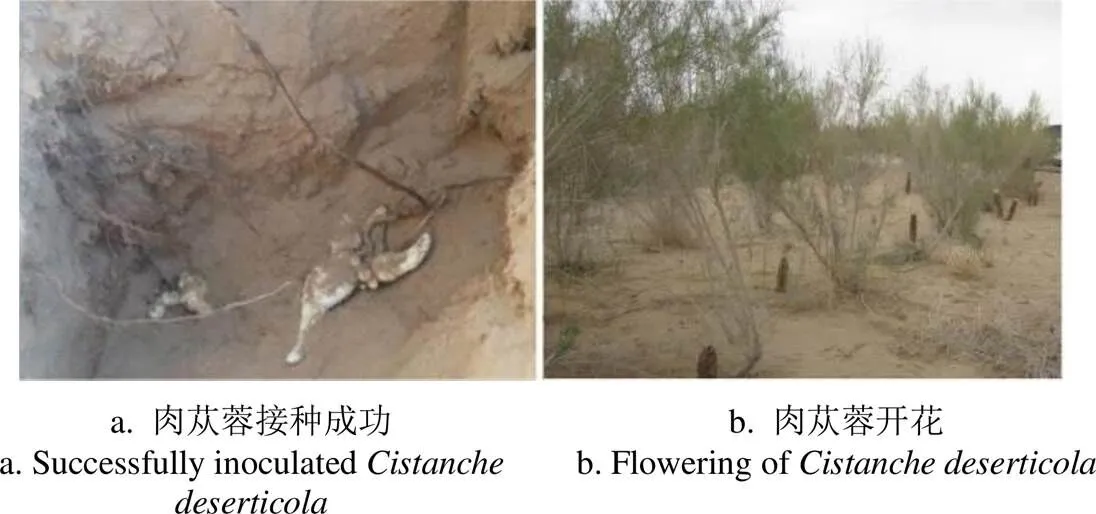
图9 采用渗灌系统后肉苁蓉生长状况

图10 复合材料X射线衍射示意图
图11为导水材料的红外光谱图,复合材料的红外特征峰和MMT较为接近,MMT中主要的特征峰在复合材料中都出现,包括1 040 cm-1处为Si-O四面体伸缩振动峰、3 436 cm-1处和1 628 cm-1处为层间水的伸缩和弯曲振动峰、3 612 cm-1处为MMT的结构羟基振动峰。相比于MMT,复合材料新增了2 930 cm-1处的亚甲基C-H反对称伸缩振动的振动峰,1 636 cm-1处的酰胺基中羰基的特征峰,1 457cm-1处的亚甲基变形的特征峰,这些峰是PAM中主要官能团的峰。复合材料中出现PAM的特征峰,说明PAM和MMT复合成功,结合X射线衍射分析结果可知,PAM是通过插层作用进入MMT片层间,与MMT复合生成复合导水材料[27-28]。
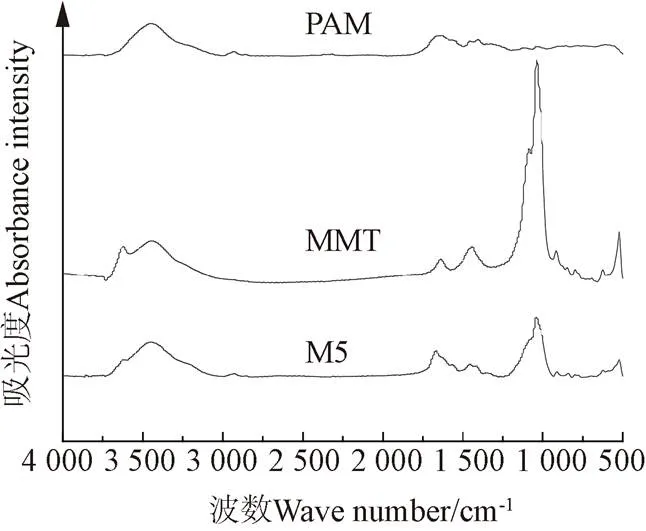
图11 复合材料的红外光谱示意图
为分析材料自调节导水过程中不同阶段微观材料内部的变化及响应机制,将自调节导水过程简化为3个典型的阶段:1)外界土壤湿度较低时;2)外界土壤湿度逐渐升高时;3)外界土壤湿度较高时。如图12所示,导水材料两端处于不同的环境,靠近水源的内侧导水材料一直处于吸水饱和状态,靠近土壤的外侧导水材料含水率随着土壤湿度而发生变化,这里主要研究靠近土壤的外侧导水材料对土壤湿度变化的响应机制。根据土壤湿度变化的3个阶段[30-32],将导水材料的变化也分为3个阶段:1)外界土壤湿度较低时,导水材料处于干燥状态;2)外界土壤湿度逐渐升高时,导水材料处于吸水状态;3)外界土壤湿度较高时,导水材料处于吸水饱和状态。
图12a为导水材料处于干燥状态的微观形貌图,PAM干燥收缩,粘附在其上的MMT也随PAM收缩而团聚粘结在一起,MMT连接形成水分快速传递通道,因此本阶段导水速率较快。图12b为导水材料吸水后的微观形貌图,PAM逐渐吸水溶胀,由于PAM未充分吸水,容易造成吸水不均匀和溶胀不均匀,左侧PAM溶胀较少,因此MMT连接在一起,右侧PAM溶胀较充分,粘附在其上的MMT随着PAM的溶胀而逐渐分开,此阶段水分由PAM和MMT共同传递,因此导水速率快速下降。图 12c为导水材料充分吸水后的微观形貌图,PAM充分溶胀形成树枝状网络结构,粘附在其上的MMT被分开,由MMT形成的水分快速传输通道被彻底切断,水分由PAM传递,因此,此阶段导水速率较慢。图12d可详细观察到随着PAM的溶胀,MMT逐渐分开的动态变化过程。

注:c图和d图中圆圈为扫描电镜聚焦处,d图是c图中圆圈处放大后的动态图。d图中箭头表示MMT颗粒分开后运动的方向。
图13为导水材料不同含水率状态下的微观结构变化情况,也即自调节导水过程中不同阶段的材料微观结构动态变化情况,结合XRD分析结果和红外光谱分析结果,可将材料通过内部微观结构,实现自动态调节导水的过程绘制成如图13所示的导水模型:当外界土壤湿度较低时,导水材料开始吸水时,PAM处于干燥收缩状态,水分通过MMT连接形成的快速通道进行传递,导水速率较快;随着导水的进行,外界土壤湿度逐渐升高,PAM逐渐吸水溶胀,部分MMT传水通道被切断,水分通过MMT通道和PAM通道共同进行传递,导水速率快速下降;当外界土壤湿度较高时,PAM逐渐吸水饱和后充分溶胀,MMT传水通道被全部切断,水分通过PAM通道进行传递,因此导水速率较低。
在实际导水中,上述3个过程总是反复交替出现,当外界土壤湿度较低时,靠近土壤一侧的导水材料含水率较低,处于较干燥状态,导水材料中聚丙烯酰胺的收缩引起蒙脱土颗粒的团聚桥联而进入水分快速传导阶段。而当外界土壤湿度较高时,靠近土壤一侧的导水材料含水率较高,导水材料中的聚丙烯酰胺会部分或全部吸水溶胀,而使导水进入导水率快速下降阶段或缓慢传水阶段,导水材料依靠蒙脱土和聚丙烯酰胺同时传水,甚至完全依靠聚丙烯酰胺单独导水,因此导水速率较低。这些导水变化过程会交替地重复出现,从而实现无压渗灌系统根据土壤湿度自调节导水速率的功能。
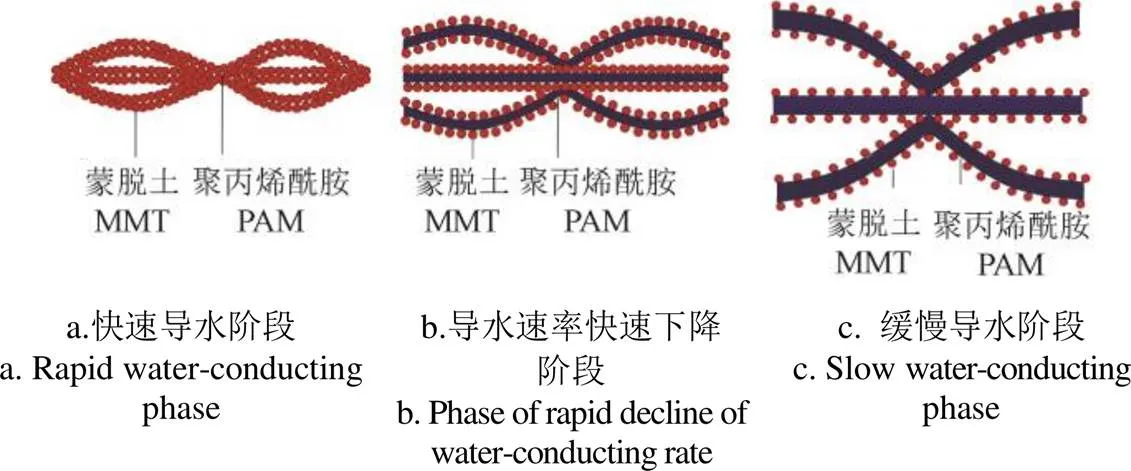
图13 导水机理示意图
3 结 论
1)利用聚丙烯酰胺(Polyacrylamide,PAM)和蒙脱土(Montmorillonite,MMT)制备复合导水材料,成膜性能和稀释水性能最佳组合为PAM和MMT的质量比0.25,复合材料可在纤维表面形成均匀涂覆的导水涂层,材料吸水和释水性能较为均衡。基于复合材料设计的渗灌系统可根据土壤湿度自调节导水速率,渗灌系统可将肉苁蓉接种率从23%提高到86%。
2)导水材料微观分析表明,导水材料主要通过PAM和MMT的相互作用调节导水速率,当土壤湿度较低时,PAM干燥收缩,MMT团聚桥联形成水分快速通道,导水率较快;当土壤湿度较高时,PAM吸水溶胀,MMT导水通道被切断,导水率较慢,因此导水材料可根据土壤湿度自调节导水速率。
本文未对渗灌系统的抗堵塞性能进行研究,抗堵塞性能是决定其使用周期的重要参数,因此渗灌系统的抗堵塞性能是将来的重要研究方向。
[1]国家林业局. 中国第五次全国荒漠化和沙化状况公报[EB/OL]. (2015-12-2) [2016-04-03]. http: //www. forestry. gov. cn/main/69/content-831684. html.
[2]吴汪洋,张登山,田丽慧,等. 青海湖克土沙地沙棘林的防风固沙机制与效益[J]. 干旱区地理,2014,37(4):777-785. Wu Wangyang, Zhang Dengshan, Tian Lihui, et al. Mechanism and benefit of wind-prevention and sand-fixation of Hippophae rhamnoides forestation in Ketu Sandy Land around Qinghai Lake[J]. Arid Land Geography, 2014, 37(4): 777-785. (in Chinese with English abstract)
[3]康绍忠,霍再林,李万红. 旱区农业高效用水及生态环境效应研究现状与展望[J]. 中国科学基金,2016(3):208-212. Kang Shaozhong, Huo Zailin, Li Wanhong. High-efficient water use and eco-environmental impacts in agriculture in arid regions: Advance and future strategies[J]. Bulletin of National Natural Science Foundation of China, 2016(3): 208-212. (in Chinese with English abstract)
[4]Nakayama F R, Bucks D A. Water quality in drip/trickle irrigation: A review[J]. Irrigation Science, 1991, 12(4): 187-192.
[5]戚迎龙,史海滨,李瑞平,等. 滴灌水肥一体化条件下覆膜对玉米生长及土壤水肥热的影响[J]. 农业工程学报,2019,35(5):99-110. Qi Yinglong, Shi Haibin, Li Ruiping, et al. Effects of film mulching on maize growth and soil water, fertilizer and heat under fertigation of drip irrigation[J]. Transactions of the Chinese Society of Agricultural Engineering (Transactions of the CSAE), 2019, 35(5): 99-110. (in Chinese with English abstract)
[6]王军,李久生,关红杰. 北疆膜下滴灌棉花产量及水分生产率对灌水量响应的模拟[J]. 农业工程学报,2016,32(3):62-68. Wang Jun, Li Jiusheng, Guan Hongjie. Modeling response of cotton yield and water productivity to irrigation amount under mulched drip irrigation in North Xinjiang[J]. Transactions of the Chinese Society of Agricultural Engineering (Transactions of the CSAE), 2016, 32(3): 62-68. (in Chinese with English abstract)
[7]王振华,扁青永,李文昊,等. 南疆沙区成龄红枣水肥一体化滴灌的水肥适宜用量[J]. 农业工程学报,2018,34(11):96-104. Wang Zhenhua, Bian Qingyong, Li Wenhao, et al. Suitable water and fertilizer amount for mature jujube with drip-irrigation under fertigation in southern Xinjiang sandy area[J]. Transactions of the Chinese Society of Agricultural Engineering (Transactions of the CSAE), 2018, 34(11): 96-104. (in Chinese with English abstract)
[8]杨小振,张显,马建祥,等. 滴灌施肥对大棚西瓜生长、产量及品质的影响[J]. 农业工程学报,2014,30(7):109-118. Yang Xiaozhen, Zhang Xian, Ma Jianxiang, et al. Effects of drip fertigation on growth, yield and quality of watermelon in plastic greenhouse[J]. Transactions of the Chinese Society of Agricultural Engineering (Transactions of the CSAE), 2014, 30(7): 109-118. (in Chinese with English abstract)
[9]邢英英,张富仓,吴立峰,等. 基于番茄产量品质水肥利用效率确定适宜滴灌灌水施肥量[J]. 农业工程学报,2015,31(增刊1):110-121. Xing Yingying, Zhang Fucang, Wu Lifeng, et al. Determination of optimal amount of irrigation and fertilizer under drip fertigated system based on tomato yield, quality, water and fertilizer use efficiency[J]. Transactions of the Chinese Society of Agricultural Engineering (Transactions of the CSAE), 2015, 31(Supp. 1): 110-121. (in Chinese with English abstract)
[10]诸葛玉平,张玉龙,张旭东,等. 渗灌土壤水分调控技术参数的研究进展[J]. 农业工程学报,2003,19(6):41-45. Zhuge Yuping, Zhang Yulong, Zhang Xudong, et al. Review on technical parameters of subsurface drip irrigation for soil water control[J]. Transactions of the Chinese Society of Agricultural Engineering (Transactions of the CSAE), 2003, 19(6): 41-45. (in Chinese with English abstract)
[11]王淑红,张玉龙,虞娜,等. 渗灌技术的发展概况及其在保护地中应用[J]. 农业工程学报,2005,21(13):92-95. Wang Shuhong, Zhang Yulong, Yu Na, et al. Development status of infiltration irrigation technology and its application in protected field[J]. Transactions of the Chinese Society of Agricultural Engineering (Transactions of the CSAE), 2005, 21(13): 92-95. (in Chinese with English abstract)
[12]蔡耀辉,吴普特,朱德兰,等. 硅藻土微孔陶瓷灌水器制备工艺优化[J]. 农业工程学报,2015,31(22):70-76. Cai Yaohui, Wu Pute, Zhu Delan, et al. Preparation technology optimization of diatomite porous ceramic irrigation emitter[J]. Transactions of the Chinese Society of Agricultural Engineering (Transactions of the CSAE), 2015, 31(22): 70-76. (in Chinese with English abstract)
[13]张增志,王晓健,薛梅. 渗灌材料制备及导水性能分析[J]. 农业工程学报,2014,30(24):74-81. Zhang Zengzhi, Wang Xiaojian, Xue Mei. Preparation and hydraulic conductivity performance analysis of infiltration irrigation materials[J]. Transactions of the Chinese Society of Agricultural Engineering (Transactions of the CSAE), 2014, 30(24): 74-81. (in Chinese with English abstract)
[14]仵峰,王富斌,宰松梅,等. 玉米秸秆复合渗灌管研制及渗水性能研究[J]. 农业工程学报,2019,35(14):98-104. Wu Feng, Wang Fubin, Zai Songmei, et al. Development and infiltration performance of corn straw composite infiltration irrigation pipe[J]. Transactions of the Chinese Society of Agricultural Engineering (Transactions of the CSAE), 2019, 35(14): 98-104. (in Chinese with English abstract)
[15]梁海军,刘作新,舒乔生,等. 橡塑渗灌管渗水性能实验研究[J]. 农业工程学报,2006,22(7):56-59. Liang Haijun, Liu Zuoxin, Shu Qiaosheng, et al. Experimental study on discharge characteristics of a subirrigation porous pipe[J]. Transactions of the Chinese Society of Agricultural Engineering (Transactions of the CSAE), 2006, 22(7): 56-59. (in Chinese with English abstract)
[16]李向明,杨建国. 微孔混凝土灌水器形状及其尺寸对流量的影响[J]. 农业工程学报,2017,33(10):130-136. Li Xiangming, Yang Jianguo. Influence of shape and size on flow rate of microporous concrete irrigation emitters[J]. Transactions of the Chinese Society of Agricultural Engineering (Transactions of the CSAE), 2017, 33(10): 130-136. (in Chinese with English abstract)
[17]蔡耀辉,吴普特,朱德兰,等. 粘土基微孔陶瓷渗灌灌水器制备与性能优化[J]. 农业机械学报,2015,46(4):183-188. Cai Yaohui, Wu Pute, Zhu Delan, et al. Preparation and performance optimization of clay-based porous ceramics used in subsurface irrigation[J]. Transactions of the Chinese Society for Agricultural Machinery, 2015, 46(4): 183-188. (in Chinese with English abstract)
[18]蔡耀辉,吴普特,张林,等. 微孔陶瓷渗灌与地下滴灌土壤水分运移特性对比[J]. 农业机械学报,2017,48(4):242-249. Cai Yaohui, Wu Pute, Zhang Lin, et al. Comparison of characteristics of soil moisture transfer for porous ceramic infiltration irrigation and subsurface drip irrigation[J]. Transactions of the Chinese Society for Agricultural Machinery, 2017, 48(4): 242-249. (in Chinese with English abstract)
[19]王耀生,张玉龙,虞娜,等. 渗灌灌水控制下限对保护地土壤剖面磷素分布的影响[J]. 农业工程学报,2009,25(6):66-70. Wang Yaosheng, Zhang Yulong, Yu Na, et al. Effect of control lower limit of subsurface irrigation on phosphorus distribution in soil profiles of protected land[J]. Transactions of the Chinese Society of Agricultural Engineering (Transactions of the CSAE), 2009, 25(6): 66-70. (in Chinese with English abstract)
[20]张超杰,张增志,陈兴龙. 适宜分散剂改善导水涂层材料中蒙脱土分散及吸脱附水性[J]. 农业工程学报,2016,32(5):82-87. Zhang Chaojie, Zhang Zengzhi, Chen Xinglong. Improvement of montmorillonite dispersion and water absorption/ dehydration of water-release coated materials with appropriate dispersants addition[J]. Transactions of the Chinese Society of Agricultural Engineering (Transactions of the CSAE), 2016, 32(5): 82-87. (in Chinese with English abstract)
[21]王辉,成煦,杜宗良. 水包水型聚丙烯酰胺/蒙脱土乳液的制备及吸附性能研究[J]. 纺织科学与工程学报,2018,35(3):33-40. Wang Hui, Cheng Xu, Du Zongliang. Preparation and adsorption performance research of W/W Polyacrlamide/ Montmorillonite nano-composite[J]. Journal of Textile Science &Engineering, 2018, 35(3): 33-40. (in Chinese with English abstract)
[22]张增志,谷娜,舒新前,等. 蒙脱土/聚丙烯酰胺复合涂层导水纤维的制备及性能[J]. 功能材料,2009,40(6):998-1000, 1004. Zhang Zengzhi, Gu Na, Shu Xinqian, et al. Preparation and properties of montmoriilonite/polyacrylamide composite water-transmitting coated fiber[J]. Journal of Functional Materials, 2009, 40(6): 998-1000, 1004. (in Chinese with English abstract)
[23]张增志,王博涛. 聚丙烯酰胺/蒙脱土复合导水涂层材料的制备及自调节导水特性[J]. 高分子材料科学与工程,2011,27(12):138-141. Zhang Zengzhi, Wang Botao. Preparation and self-regulating water conductivity properties of polyacrylamide/ montmorillonite composite water-transmitting coating[J]. Polymer Materials Science & Engineering, 2011, 27(12): 138-141. (in Chinese with English abstract)
[24]张增志,王晓健,薛梅. 渗灌材料制备及导水性能分析[J]. 农业工程学报,2014,30(24):74-81. Zhang Zengzhi, Wang Xiaojian, Xue Mei. Preparation and hydraulic conductivity performance analysis of infiltration irrigation materials[J]. Transactions of the Chinese Society of Agricultural Engineering (Transactions of the CSAE), 2014, 30(24): 74-81. (in Chinese with English abstract)
[25]张增志,渠永平,张利梅,等. 不同粘土与聚丙烯酰胺复合导水涂层的自调节导水性能及机理[J]. 高分子材料科学与工程,2015,31(6):144-148. Zhang Zengzhi, Qu Yongping, Zhang Limei, et al. Self-adjusting water conductivity property and mechanism of water-Release coatings prepared with polyacrylamide and differernt clays[J]. Polymer Materials Science & Engineering, 2015,31(6):144-148. (in Chinese with English abstract)
[26]马毓泉. 内蒙古肉苁蓉属订正[J]. 内蒙古大学学报:自然科学版,1977(1):69-75.
[27]Wu Guozhong, Yang Lu, Qi Hanbing, et al. Optical constants of polyacrylamide solution in the infrared between 20 and 70 ℃[J]. Optik, 2018, 155: 171-178.
[28]Fanny Claverie, Christophe Pécheyran, Sandra Mounicou, et al. Characterization of the aerosol produced by infrared femtosecond laser ablation of polyacrylamide gels for the sensitive inductively coupled plasma mass spectrometry detection of selenoproteins[J]. Spectrochimica Acta Part B: Atomic Spectroscopy, 2009, 64(7): 649-658.
[29]邱静红,Komarneni Sridhar,成煦,等. W/W型PAM–MMT乳液的制备及性能研究[J]. 工程科学与技术,2019,51(2):193-198. Qiu Jinghong, Komarneni Sridhar, Cheng Xu, et al. Study on preparation and characterization of the PAM–MMT W/W emulsion[J]. Advanced Engineering Sciences, 2019, 51(2): 193–198. (in Chinese with English abstract)
[30]渠永平. 蒙脱土/聚丙烯酰胺复合导水材料水分运移动力学研究[D]. 北京:中国矿业大学,2016. Qu Yongping. Study on the Water Transport Dynamics of Montmorillonite/Polyacrylamide Composite Water Conducting Material[D]. Beijing: China University of Mining and Technology, 2016. (in Chinese with English abstract)
[31]Zhang Zengzhi, Xu Hongmei. Micro-dynamic behavior and self-adjusting water transmit mechanism of water-transferring composite[J]. Journal of Wuhan University of Technology: Materials Science Edition, 2011, 26(6): 1193-1199.
[32]Du Hongmei, Zhang Zengzhi, Wu Miaomiao, et al. Water-conducting characteristics and micro-dynamic self-adjusting behavior of polyacrylamide/montinorillonite coating[J]. Journal of Wuhan University of Technology: Materials Science Edition, 2015, 30(6): 1191-1197.
Preparation of polyacrylamide/montmorillonite infiltrating irrigation material and field test of its water conducting performance
Qu Yongping1,2, Zhang Zengzhi3
(1.,,030051,; 2.,030051,; 3.,(),100083,)
Based on the characteristics of micro water requirement of psammophytes, a kind of infiltrating irrigation composite material was prepared by using Polyacrylamide (PAM) and Montmorillonite (MMT). An infiltrating irrigation system was then designed based on the composite material. The film-forming properties of the composite water conducting materials with different proportions of PAM and MMT were observed and analyzed by using a scanning electron microscope, and water absorption performance and water release performance of the material were tested in air and sand. The composite water conducting materials were made into an infiltrating irrigation emitter, and the water conductivity of the infiltrating irrigation head was studied. On this basis, an infiltration irrigation system was designed, and then water transmission performance of the infiltration irrigation system was studied. A field test of infiltrating irrigation system in Ulan Buhe desert was carried out. The self-regulation mechanism of composite material was analyzed by X-ray diffraction, infrared spectrum analyzer and scanning electron microscope. The results showed that the best mass ratio of PAM to MMT was 0.25. The material had good coating uniformity on the fiber surface. The water absorption test showed that, in the first 40 min, the water absorption increased rapidly. From 40 to 120 min, the water absorption continued to increase, but the water absorption rate began to decrease gradually. After 120 min, the water absorption amount changed little, and the water absorption rate almost dropped to 0. The water absorption amount was 30.2 g/g at 150 min. In air, the composite released water rapidly in the first 50 minutes, and then kept stable until 140 minutes, reaching 24.2 g/g. The water release rate in dry sand was slightly higher than it in air. The water release reached 28.5 g/g. The water conducting test of infiltrating irrigation emitter showed that the soil moisture content was 13% after the water diversion was stable, indicating that the soil moisture content could meet the growth needs of. The water conducting tests of infiltrating irrigation showed that the effluent rate of irrigating system gradually decreased within 24 h, and the initial effluent rate reached 52 mL/h, and then decreased rapidly to 21 mL/h at 6 h. The effluent rate began to slow down and tend to be stable, and the effluent rate was 7 mL/h at 24 h. The water conducting curve of infiltrating irrigation system within 7 days showed that the water conducting rate was 420 mL/d on the first day, and then kept stable at about 160 mL/ d. In the three dry and wet cycles, the water conductivity of the infiltrating irrigation system was 420 mL/d in the first day, and 165 mL/h in the second to third day. The results showed that when the external soil moisture was low, the hydraulic conductivity of the infiltrating irrigation system was faster (about 420 mL/d), and with the water conduction, the external soil moisture gradually increased, and the water conducting rate of the infiltrating irrigation system decreased and remained stable. When the soil moisture decreased again, the water conductivity of the infiltrating irrigation system would increase again. So the dry and wet alternating test showed that it could self-regulate the water conducting rate according to the soil moisture, and the inoculation rate ofimproved from 23% to 86%. The infrared spectrum analysis results showed that the lamellar structure of MMT had not been destroyed, and PAM was connected to MMT by intercalation effect. X-ray diffractometer analysis results showed that the laminar spacing of MMT increased from 1.21 to 1.45 nm after intercalation reactions. The microscopic analysis showed that the water conducting materials mainly relied on the interaction between PAM and MMT to transfer water. When the soil moisture was low, the moisture content of the water conducting materials near the soil side decreased and was in a relatively dry state, and the MMT particles aggregated to form a rapid water conducting channel. When the external soil moisture was high, the moisture content of the water conducting material near the soil side was also high, and it was in the state of water absorption and swelling. The water conducting channel of montmorillonite was cut off, and the water conducting rate dropped rapidly so as to realize the self-regulation of the water conducting rate of the composite material. The results could provide information for the application of seepage irrigation materials.
desertification; polyacrylamide; montmorillonite; infiltrating irrigation; water conducting
10.11975/j.issn.1002-6819.2020.18.018
TB34
A
1002-6819(2020)-18-0144-09
渠永平,张增志. 聚丙烯酰胺/蒙脱土渗灌材料制备及其导水性能野外试验[J]. 农业工程学报,2020,36(18):144-152.doi:10.11975/j.issn.1002-6819.2020.18.018 http://www.tcsae.org
Qu Yongping, Zhang Zengzhi. Preparation of polyacrylamide/montmorillonite infiltrating irrigation material and field test of its water conducting performance[J]. Transactions of the Chinese Society of Agricultural Engineering (Transactions of the CSAE), 2020, 36(18): 144-152. (in Chinese with English abstract) doi:10.11975/j.issn.1002-6819.2020.18.018 http://www.tcsae.org
2020-03-16
2020-07-10
国家自然科学基金资助项目(50772131);教育部重点项目(106086);山西省高等学校科技创新项目(2019L0567);山西省科技重大专项(20181101003);山西省应用基础研究计划(201801D221147)和中北大学校科学研究基金项目(2017-24)联合资助
渠永平,博士,副教授,主要从事荒漠化治理及节水灌溉研究。Email:quyongping1989@163.com
中国农业工程学会会员:渠永平(E041000021M)

